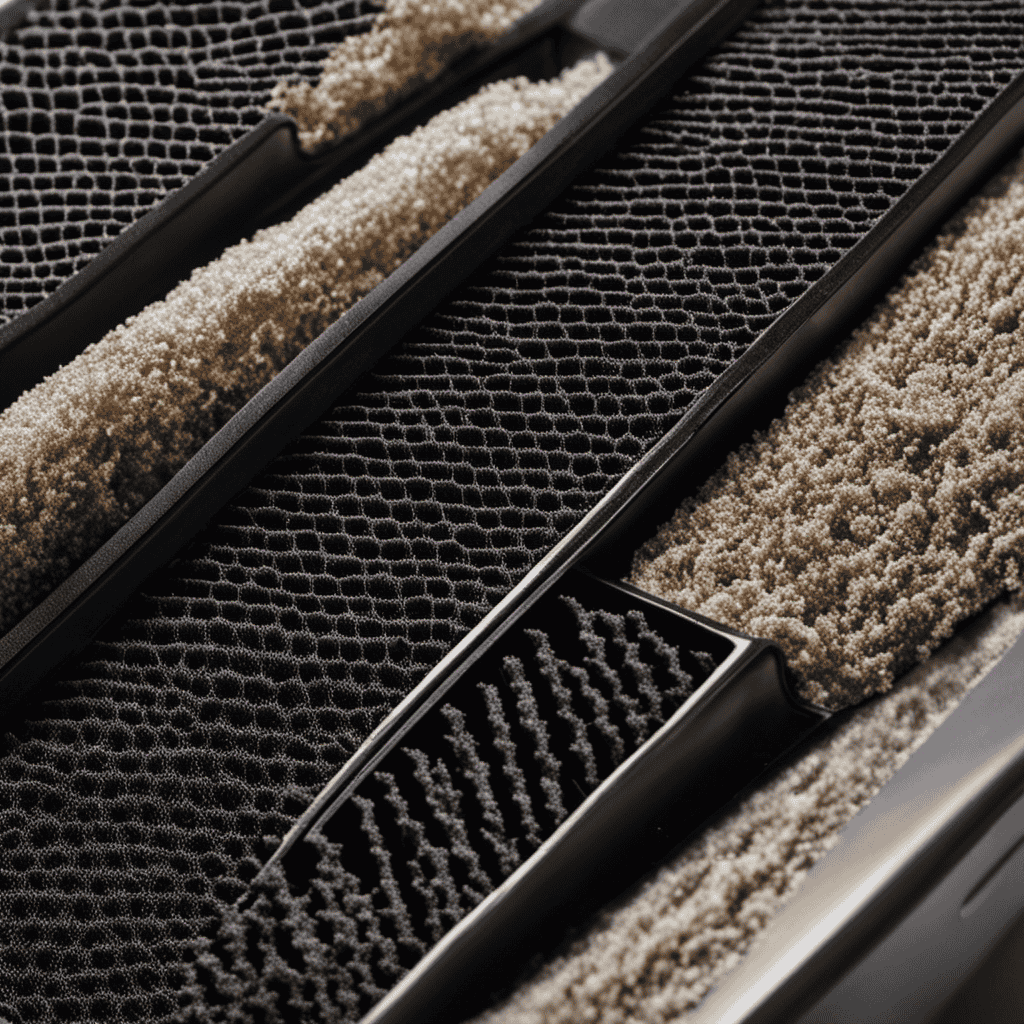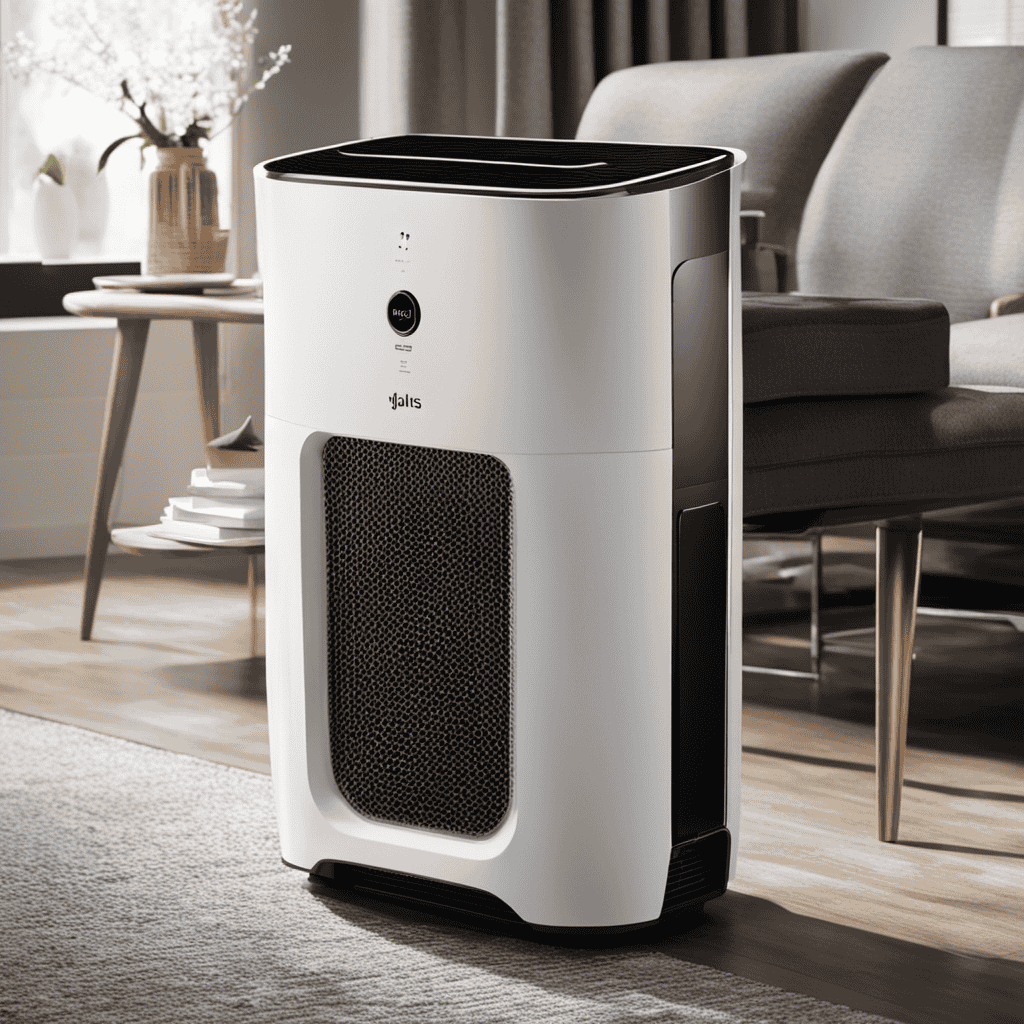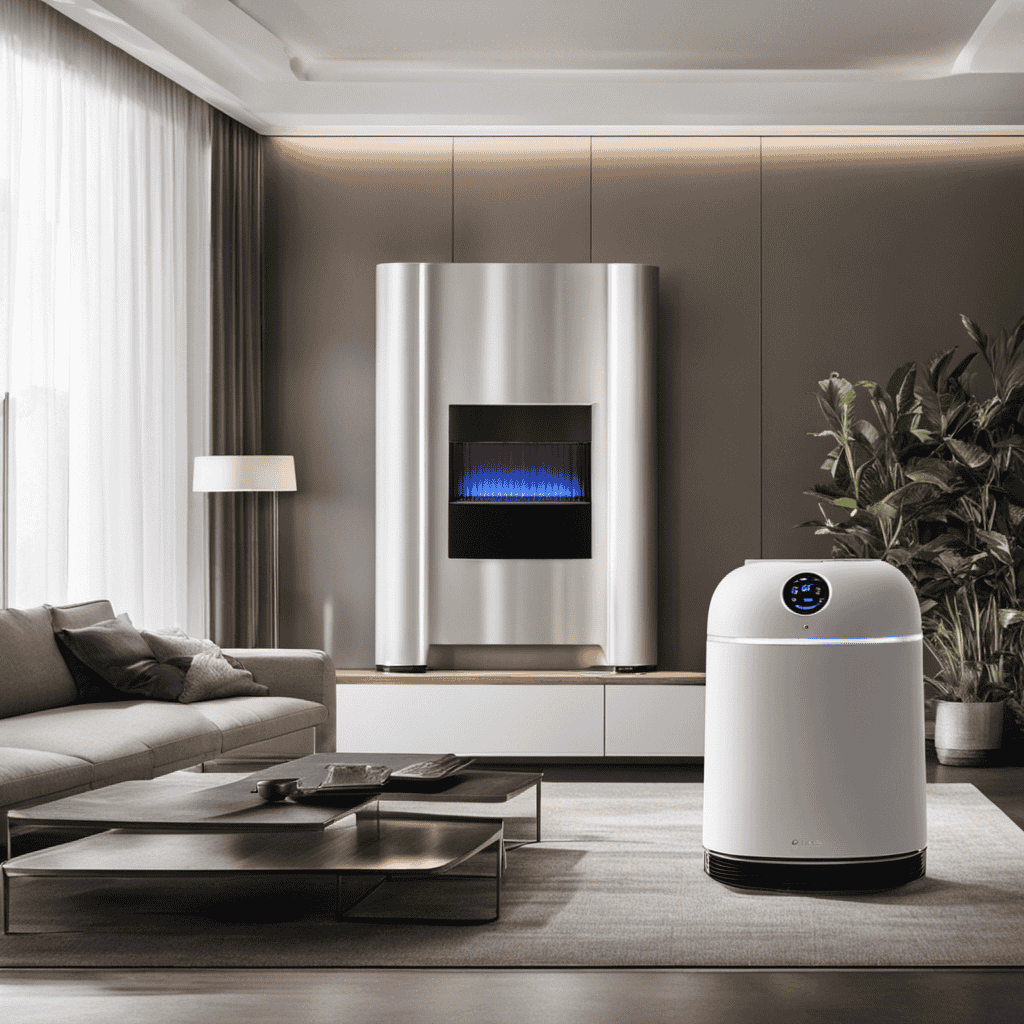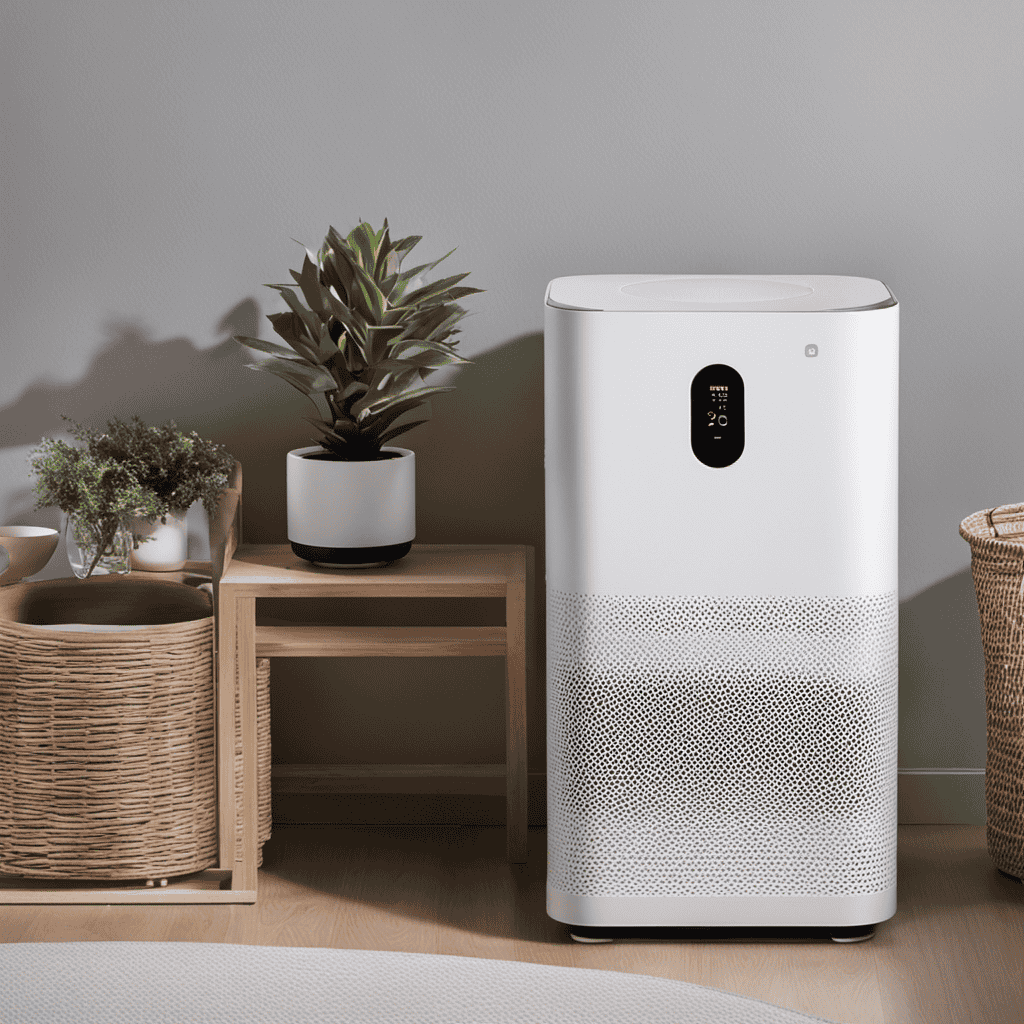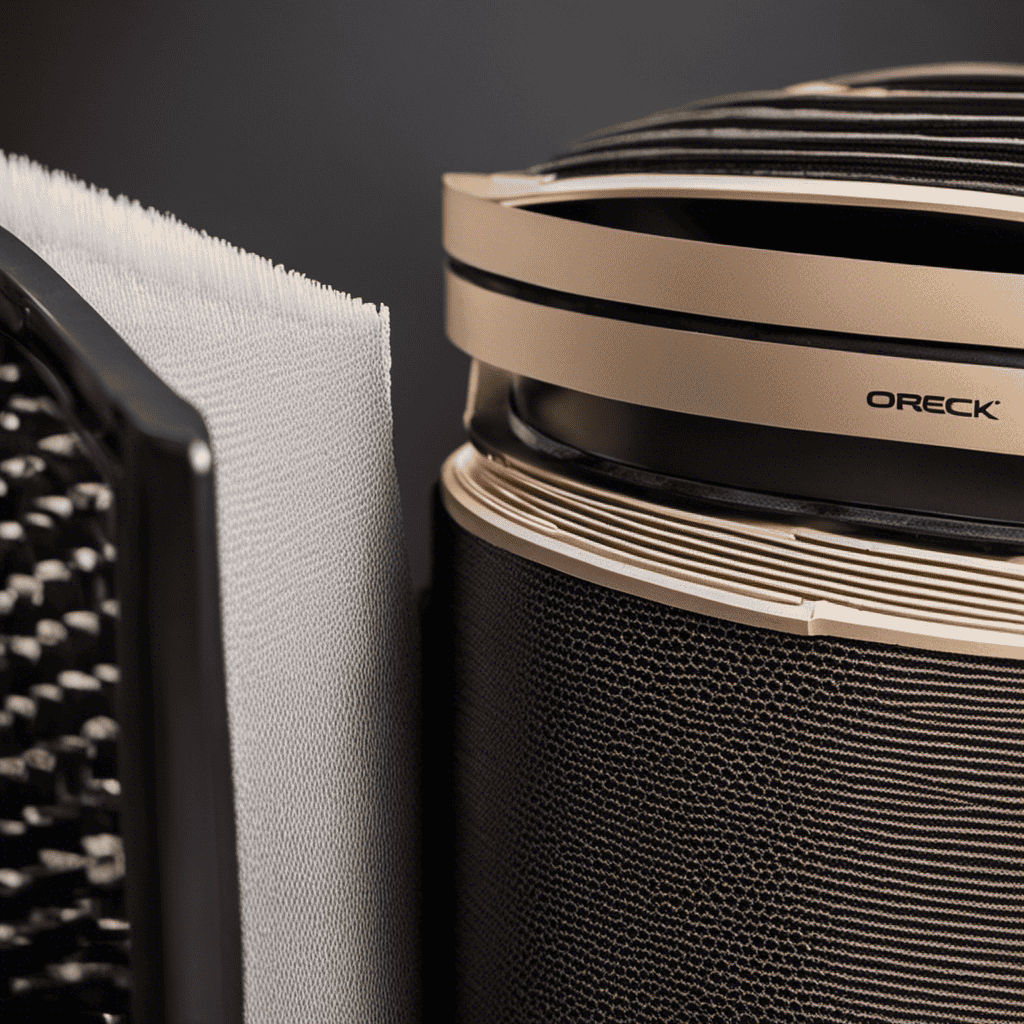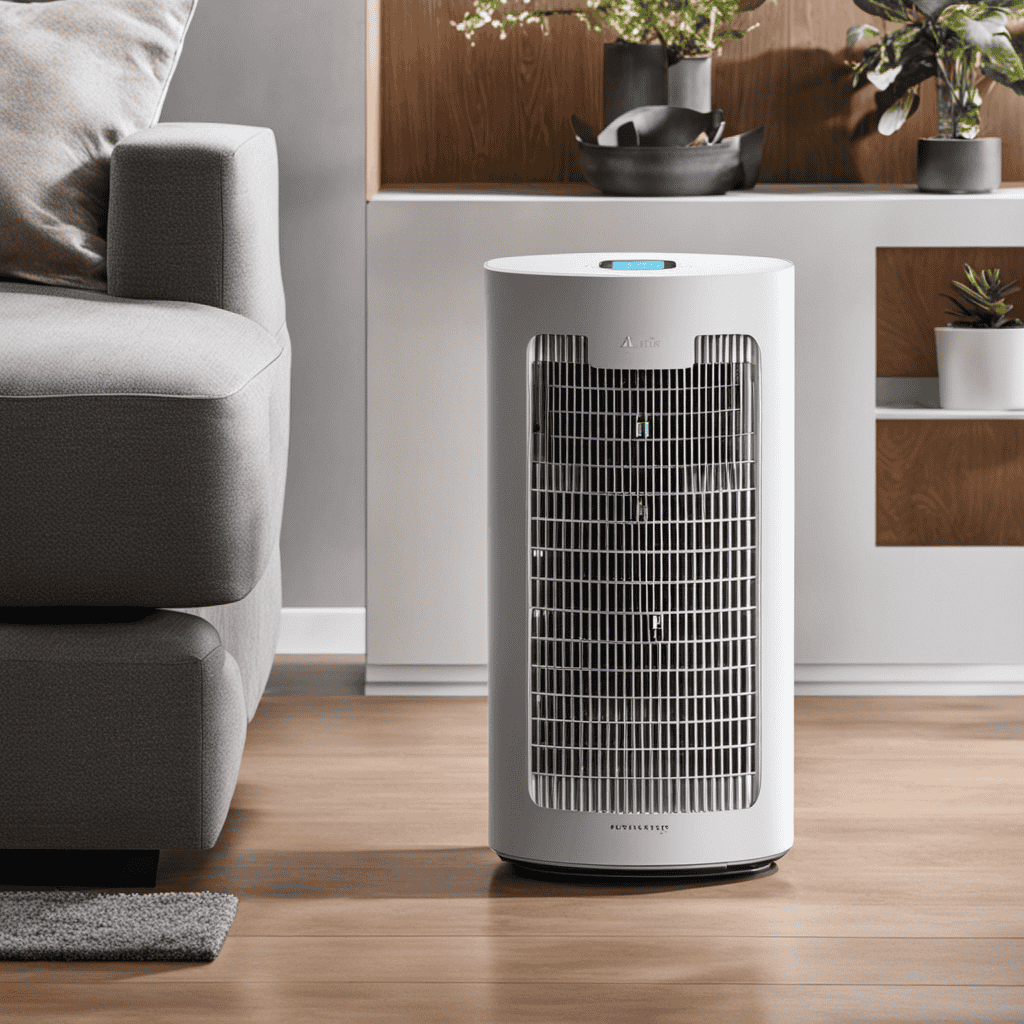I have noticed an improvement in my breathing ever since I started using my Austin Air Purifier. However, I have come to understand that even the highest quality filters require regular replacement in order to continue working effectively.
In this article, I’ll share the signs that indicate it’s time to replace your air purifier filter and give you tips on how to extend its lifespan.
We’ll also discuss the importance of regular maintenance and where to find replacement filters for Austin Air Purifiers.
Don’t miss out on this crucial information that will help you keep your indoor air clean and healthy.
Key Takeaways
- The lifespan of Austin Air Purifier filters can be affected by factors such as the level of pollution in the surroundings, the presence of pets in the home, and common mistakes in filter maintenance.
- Signs of a dirty filter include unusual odors, discoloration or mold growth, grinding or buzzing noises, and weaker air output from the purifier.
- The recommended frequency for filter replacement varies based on the air purifier type and factors influencing lifespan extension. Regular cleaning and maintenance, avoiding excessive moisture or humidity, and keeping the purifier in a well-ventilated area can help extend the lifespan of the filter.
- Regular filter maintenance is crucial for optimal performance, improved air quality, enhanced performance of the air purifier, longer lifespan of the air purifier, reduced maintenance costs, and health benefits of breathing clean air. Different filters have different lifespans, and health concerns may require more frequent filter changes.
Factors That Affect Filter Lifespan
If you have pets or live in a dusty environment, you’ll need to change your Austin Air purifier filters more frequently. There are several factors that can affect the efficiency and lifespan of your filters.
Firstly, the level of pollution in your surroundings plays a significant role. If you live in an area with high levels of air pollution, such as near a busy road or industrial area, your filters will get clogged faster and require more frequent replacement.
Additionally, the number of pets in your home can also impact filter efficiency. Pet dander and hair can quickly accumulate in the filters, reducing their effectiveness.
Lastly, common mistakes in filter maintenance, such as not cleaning the pre-filter regularly or forgetting to replace the carbon filter, can also decrease the lifespan of your filters.
It is crucial to follow the manufacturer’s guidelines and perform regular maintenance to ensure optimal filter efficiency.
Signs That It’s Time to Change Your Air Purifier Filter
You’ll know it’s time to replace the filter in your Austin air purifier when you notice a decrease in air flow or a buildup of dust on the surface. Regularly checking filter efficiency is crucial to ensure that your air purifier is effectively removing common air pollutants from your home.
Here are some signs that indicate it’s time for a filter replacement:
-
Reduced air flow: If you feel that the air circulation in your room has decreased, it could be a sign that your filter is clogged and needs to be replaced.
-
Dust buildup: If you notice a significant amount of dust accumulating on the surface of your filter, it means that the filter is no longer able to capture the airborne particles effectively.
-
Increased allergies or respiratory issues: If you or your family members start experiencing more allergy symptoms or respiratory problems, it could be a sign that the filter is no longer working properly.
-
Unpleasant odors: If there are persistent odors in your home, it may indicate that your filter is saturated and unable to eliminate airborne pollutants effectively.
-
Filter lifespan: It’s essential to replace your filter according to the manufacturer’s recommendations, as filters have a limited lifespan and become less efficient over time.
Recommended Frequency for Filter Replacement
When it comes to optimal filter replacement and extending filter lifespan, there are a few key points to consider.
First, it is important to understand the recommended frequency for filter replacement based on the type of air purifier you have. This can vary depending on factors such as the size of the unit, the level of air pollution in your area, and the usage of the purifier.
Additionally, there are certain measures you can take to extend the lifespan of your filter. These include regular cleaning and maintenance, avoiding exposure to excessive moisture or humidity, and keeping the purifier in a well-ventilated area.
Taking these steps will help ensure that your air purifier continues to effectively clean the air in your space and that you get the most out of your filter before needing to replace it.
Optimal Filter Replacement
To ensure your Austin air purifier is functioning at its best, it’s important that you regularly replace the filters. Regular filter replacement is essential for maintaining optimal air quality in your home or office. Here are some factors that can affect the lifespan of your air purifier filters:
- Environmental conditions: High levels of pollutants or allergens in the air can cause filters to become clogged more quickly.
- Frequency of use: The more frequently an air purifier is used, the more often the filters will need to be replaced.
- Filter type: Different types of filters have varying lifespans, so it’s important to follow the manufacturer’s recommendations.
- Filter maintenance: Regularly cleaning and maintaining your filters can help prolong their lifespan.
- Indoor air quality: If the air in your environment is particularly polluted, the filters may need to be replaced more frequently.
Regularly replacing your Austin air purifier filters has several benefits:
- Improved air quality: Fresh filters ensure that the air you breathe is free from pollutants, allergens, and other harmful particles.
- Enhanced performance: Clean filters allow the air purifier to work more efficiently, effectively capturing and removing contaminants.
- Longer lifespan of the air purifier: By regularly replacing filters, you can prevent damage to the air purifier and extend its overall lifespan.
- Reduced maintenance costs: Proper filter replacement can help prevent the need for costly repairs or replacements in the future.
- Health benefits: Breathing clean air can help reduce allergies, asthma symptoms, and other respiratory issues.
Extended Filter Lifespan
Regular cleaning and maintenance of your filters can significantly extend their lifespan, ensuring optimal performance of your air purifier. By keeping your filters clean, you can save money in the long run by avoiding frequent replacements.
There are cost-effective options available, such as DIY filter cleaning, which can be done easily at home. To clean your filters, start by turning off your air purifier and unplugging it. Carefully remove the filters and gently brush off any visible dirt or debris. You can also use a vacuum cleaner with a brush attachment to remove stubborn particles.
If the filters are washable, rinse them with water and let them air dry completely before reinstalling. Regular cleaning and maintenance not only prolongs the lifespan of your filters but also ensures that your air purifier continues to effectively remove airborne pollutants from your indoor environment.
How to Check if Your Filter Needs Changing
When it comes to checking if your filter needs changing, there are several methods you can use.
One common method is visual inspection, where you examine the filter for any visible dirt or debris buildup.
Additionally, you can look out for airflow reduction indicators, such as decreased air circulation or increased noise levels from the purifier.
Lastly, it’s essential to consult the manufacturer’s recommended schedule for filter replacement, as they often provide specific guidelines based on the type of filter and usage.
Visual Inspection Methods
Take a close look at the filters in your Austin air purifier to visually inspect them for any signs of dirt or damage. It’s important to regularly check your filters to ensure they are functioning properly and providing clean air for your home.
Here is an inspection checklist to help you identify any common filter problems:
- Look for a buildup of dust or debris on the surface of the filter.
- Check for any tears or holes in the filter material.
- Inspect the filter frame for any cracks or damage.
- Pay attention to any unusual odors coming from the filter.
- Examine the filter for discoloration or mold growth.
Airflow Reduction Indicators
Check for any signs of reduced airflow in your Austin air purifier by paying attention to unusual sounds or weaker air output. A dirty filter is one of the main causes of reduced airflow in air purifiers. Regular filter maintenance is crucial to ensure optimal performance and clean air in your home. Here are some indicators that your air purifier’s filter may need cleaning or replacement:
| Indicator | Description | Action Required |
|---|---|---|
| Unusual Sounds | Grinding, rattling, or buzzing noises indicate a clogged filter. | Clean or replace the filter. |
| Weaker Air Output | If the air coming out of the purifier feels weaker than usual, it may be due to a dirty filter. | Clean or replace the filter. |
| Reduced Airflow | A noticeable decrease in the amount of air being circulated by the purifier. | Clean or replace the filter. |
Keeping track of these indicators will help you determine when it’s time to clean or replace your Austin air purifier’s filter. Regular filter maintenance is essential to ensure the longevity and effectiveness of your purifier.
Manufacturer’s Recommended Schedule
In my previous discussion, I talked about the indicators of reduced airflow in Austin Air purifiers. Now, let’s delve into the importance of following the manufacturer’s recommended schedule for changing filters.
This schedule is based on careful consideration of various factors that affect filter efficiency:
-
Air Quality: Depending on your location, the air quality can vary. Areas with high pollution levels may require more frequent filter changes.
-
Usage: The frequency of filter replacement depends on how often the purifier is used. Continuous use in a heavily polluted environment will necessitate more frequent changes.
-
Filter Type: Different filters have different lifespans. HEPA filters, for example, typically last longer than carbon filters.
-
Filter Condition: The condition of the filter itself is essential. A clogged or damaged filter will reduce its efficiency, requiring replacement.
-
Health Concerns: Individuals with allergies or respiratory issues may require more frequent filter changes to maintain clean air.
Following the manufacturer’s recommendations ensures optimal performance and efficiency of your Austin Air purifier, allowing it to effectively remove harmful pollutants from your indoor environment.
Importance of Regular Filter Maintenance
Regular filter maintenance is crucial for keeping your Austin air purifier working effectively.
There are several factors that can affect the performance of your air filter. One of these factors is the level of pollutants in the air. If the air in your environment is highly polluted, the filter will get clogged more quickly, reducing its effectiveness.
Another factor is the frequency of use. If you use your air purifier constantly, the filter will need to be replaced more often.
Clean air filters offer several benefits. They remove harmful particles from the air, such as dust, pollen, and pet dander, improving the overall air quality. This can help to reduce allergies and respiratory issues.
Regular filter maintenance ensures that your air purifier continues to provide clean and healthy air for you and your family.
Extending the Life of Your Air Purifier Filter
To make your air purifier filter last longer, you should consider vacuuming it regularly. Dust and debris can accumulate on the filter, reducing its effectiveness and lifespan.
Here are some ways to clean air purifier filters and perform DIY air purifier maintenance:
- Vacuum the filter gently using a soft brush attachment to remove large particles.
- Use compressed air to blow off any remaining dust or debris.
- Rinse the filter with water if it is washable, following the manufacturer’s instructions.
- Allow the filter to dry completely before reinstalling it.
- Consider using a pre-filter to trap larger particles and extend the life of the main filter.
Regular maintenance and cleaning of your air purifier filter will ensure that it continues to provide clean and healthy air for a longer period of time.
Where to Find Replacement Filters for Austin Air Purifiers
You can easily find replacement filters for Austin air purifiers online or at local home improvement stores. It’s important to regularly change your air purifier filters to maintain optimal performance and ensure clean indoor air.
When it comes to air purifier maintenance, here are a few tips to keep in mind:
-
Check the manufacturer’s guidelines for filter replacement frequency. This can vary depending on the model and usage.
-
Consider cost-effective filter replacement options. Some filters can be washed and reused, while others may have lower-cost alternatives available.
-
Keep track of the filter’s condition and airflow. If you notice a decrease in air quality or reduced airflow, it may be time to replace the filter.
Frequently Asked Questions
Can I Wash and Reuse My Austin Air Purifier Filter?
No, you cannot wash and reuse your Austin air purifier filter. It is important to follow the manufacturer’s instructions for filter replacement to ensure optimal performance and maintain clean air quality in your home.
How Do I Properly Dispose of a Used Air Purifier Filter?
When it’s time to properly dispose of a used air purifier filter, there are recycling options available. Following the manufacturer’s guidelines, you can ensure the proper handling and recycling of the filter material.
Are There Any Health Risks Associated With Not Changing the Air Purifier Filter Regularly?
Not changing the air purifier filter regularly can pose health risks. Prolonged filter use can lead to decreased air quality, increased allergens, and reduced effectiveness of the purifier. It is important to change filters as recommended.
Can I Use a Third-Party Filter in My Austin Air Purifier?
Sure, I can use a third-party filter in my Austin Air purifier, but compatibility issues might arise. It’s essential to check if the filter meets the specifications required by the purifier for optimal performance.
Are There Any Specific Cleaning Products or Methods Recommended for Maintaining the Air Purifier Filter?
When it comes to maintaining air purifier filters, using the right cleaning products is essential. Following these tips will help prolong the filter’s lifespan and ensure optimal performance.
Conclusion
In conclusion, maintaining clean air in our homes is crucial for our health and well-being. Regularly changing the filters in our Austin Air Purifiers is essential to ensure optimal performance and effectiveness.
By following the recommended frequency for filter replacement and conducting regular maintenance, we can extend the life of our air purifier filters and continue to enjoy clean and fresh air.
Remember, as the saying goes, "A breath of fresh air is like a refreshing breeze that invigorates the soul and rejuvenates the body."
